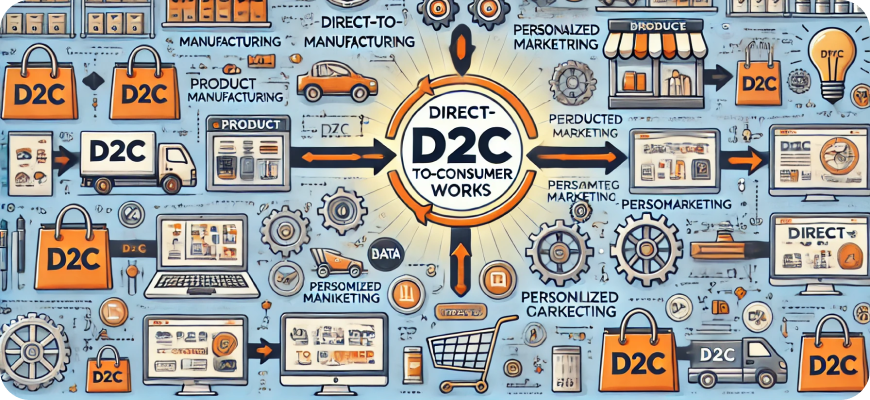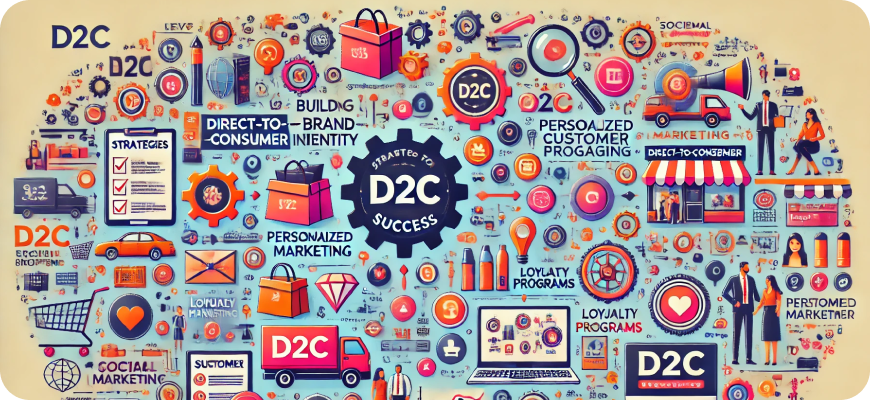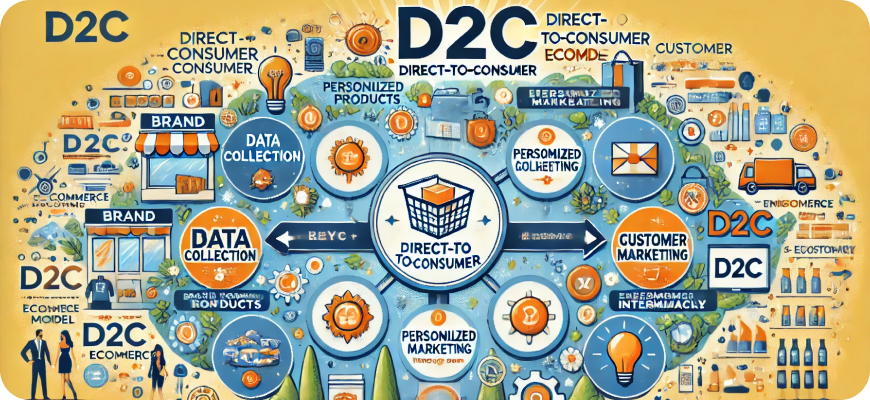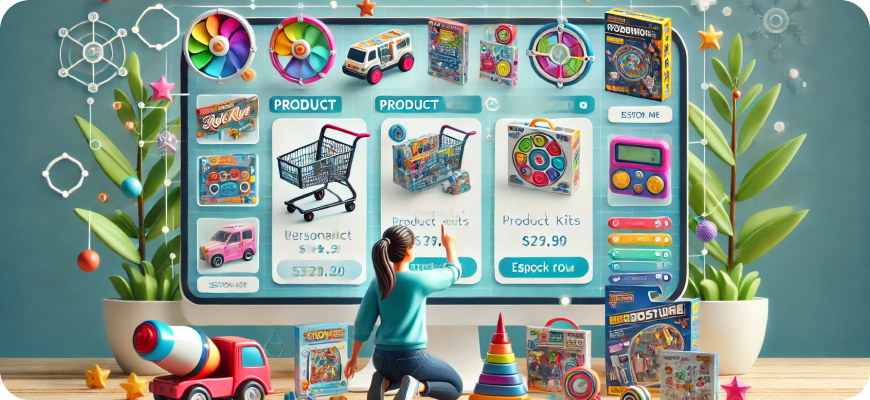What is D2C in Ecommerce? Understanding the Direct-to-Consumer Model
Direct-to-consumer (D2C) is a revolutionary business model that is rapidly reshaping the ecommerce landscape. In the traditional retail model, manufacturers and brands typically rely on intermediaries such as wholesalers, distributors, and retailers to sell their products to consumers. The D2C approach, however, allows brands to sell their products directly to their customers, eliminating middlemen. This model has gained tremendous popularity in recent years due to advances in technology, changes in consumer behavior, and the rise of ecommerce platforms. In this article, we’ll explore what D2C in ecommerce is, how it works, its advantages and challenges, and how brands can succeed with a D2C strategy.

Understanding the D2C Model
The D2C model involves selling products directly to consumers via a brand’s own ecommerce platform, such as a website or mobile app. Unlike traditional retail channels, where manufacturers rely on third parties to reach end customers, D2C brands take complete ownership of the entire sales and distribution process. This allows them to control everything from branding and marketing to pricing, customer service, and data collection.
Examples of successful D2C brands include Warby Parker, Dollar Shave Club, Glossier, Casper, and Allbirds. These companies disrupted traditional industries by using innovative marketing, unique customer experiences, and direct access to their target audiences.
How Does the D2C Model Work?

To better understand the D2C model, it helps to break down its key components:
- Direct Selling: Unlike traditional manufacturers who rely on wholesalers and retailers to sell their products, D2C brands sell directly to their customers through their own ecommerce channels. This allows brands to have a direct relationship with their customers, which can lead to better engagement and loyalty.
- Brand Ownership: D2C brands have full control over their branding, messaging, and customer interactions. This level of control enables brands to create a cohesive and consistent brand experience that resonates with their target audience.
- Customer Data Collection: By selling directly to consumers, D2C brands gain access to valuable first-party data, such as customer preferences, buying behaviors, and feedback. This data can be used to personalize marketing campaigns, improve product offerings, and enhance customer experiences.
- Ecommerce Platforms: Most D2C brands rely on their own ecommerce websites, mobile apps, or third-party platforms to facilitate sales. By leveraging technology, brands can provide a seamless shopping experience with features such as product recommendations, personalized offers, and efficient checkout processes.
Advantages of the D2C Model
The D2C model offers several key advantages for both brands and consumers, making it an appealing option for many businesses.
1. Higher Profit Margins
One of the most significant advantages of the D2C model is the ability to eliminate intermediaries, which can reduce costs and increase profit margins. When brands bypass wholesalers, distributors, and retailers, they can retain a larger share of the revenue generated from sales.
- Lower overhead costs: By cutting out middlemen, brands can reduce distribution and retail costs.
- Price control: D2C brands can control their pricing strategy, which allows them to set competitive prices or offer attractive promotions without compromising profitability.
2. Direct Customer Relationships
Selling directly to consumers enables brands to build strong, long-lasting relationships with their customers. This direct connection provides several benefits:
- Customer engagement: D2C brands can engage directly with their customers through email marketing, social media, customer support, and other channels.
- Brand loyalty: Building a loyal customer base is easier when brands can communicate their values, mission, and unique selling propositions (USPs) directly to their audience.
- Real-time feedback: D2C brands can gather and act on customer feedback quickly, allowing them to make data-driven decisions that improve products and customer experiences.
3. Control Over Branding and Messaging
In a crowded marketplace, strong branding is essential for standing out. The D2C model allows brands to maintain full control over their brand identity, messaging, and marketing efforts.
- Consistent brand experience: D2C brands can ensure that customers have a consistent experience across all touchpoints, from the website and packaging to customer support interactions.
- Storytelling and brand values: D2C brands can create compelling narratives around their products, mission, and values, which helps differentiate them from competitors and build emotional connections with customers.
4. Better Use of Customer Data
Access to first-party data is a major advantage of the D2C model. This data allows brands to better understand their customers’ needs and preferences, leading to more effective marketing strategies and product development.
- Personalized marketing: D2C brands can use customer data to deliver highly targeted and personalized marketing campaigns, such as product recommendations, special offers, and loyalty rewards.
- Customer insights: Analyzing customer data helps brands identify trends, optimize pricing strategies, and forecast demand.
5. Faster Time-to-Market
D2C brands have greater flexibility and agility in bringing new products to market. Unlike traditional retail channels, which often involve lengthy approval and distribution processes, D2C brands can launch new products directly on their ecommerce platforms.
- Quick product launches: Brands can rapidly introduce new products, test different variations, and iterate based on customer feedback.
- Experimentation and innovation: D2C brands can experiment with product features, designs, and pricing models to find what resonates best with their audience.
Challenges of the D2C Model
While the D2C model offers many advantages, it also comes with its own set of challenges that brands must navigate to be successful.
1. Increased Responsibility
Operating a D2C business requires brands to take on responsibilities that are typically handled by intermediaries, such as logistics, customer support, marketing, and inventory management. This can be resource-intensive and complex.
- Supply chain management: Brands must manage inventory, warehousing, shipping, and returns, which can be time-consuming and costly.
- Customer service: Providing excellent customer service is critical in a D2C model, as customers expect a high level of support and responsiveness.
2. High Competition
The D2C market has become increasingly competitive, with new entrants regularly launching innovative brands. Standing out in such a crowded space requires creative marketing, unique products, and a strong brand identity.
- Market saturation: Many industries, such as beauty, fashion, and health, are saturated with D2C brands vying for consumer attention.
- Customer acquisition costs: Acquiring new customers can be expensive, especially with the rising costs of digital advertising.
3. Scaling Challenges
While D2C brands often start with a niche audience, scaling the business to reach a broader market can be challenging.
- Operational complexity: As sales volumes increase, brands may need to invest in additional infrastructure, technology, and resources to meet demand.
- International expansion: Expanding into new markets may involve navigating different regulations, cultural nuances, and logistical challenges.
4. Reliance on Digital Marketing
D2C brands rely heavily on digital marketing channels such as social media, search engine optimization (SEO), email marketing, and paid advertising. Changes in digital advertising costs, platform algorithms, or privacy regulations can impact a brand’s marketing effectiveness.
- Ad fatigue: Consumers may become less responsive to digital ads over time, making it harder to attract attention.
- Privacy regulations: Stricter privacy laws and changes to data tracking (e.g., the deprecation of third-party cookies) can limit the effectiveness of targeted advertising.
Strategies for D2C Success

To succeed with a D2C strategy, brands must adopt a customer-centric approach and leverage best practices for building trust, loyalty, and brand differentiation.
1. Prioritize Customer Experience
Providing an exceptional customer experience is key to building loyalty and driving repeat purchases.
- Seamless website experience: Ensure your website is user-friendly, fast-loading, mobile-optimized, and easy to navigate.
- Personalization: Leverage customer data to deliver personalized product recommendations, promotions, and content.
- Responsive support: Offer multiple channels for customer support, such as live chat, email, and phone, and ensure fast response times.
2. Build a Strong Brand Identity
A strong brand identity helps D2C companies differentiate themselves in a crowded market and create emotional connections with their customers.
- Compelling storytelling: Share your brand’s story, mission, and values in a way that resonates with your target audience.
- Consistent branding: Ensure your brand’s voice, visual elements, and messaging are consistent across all touchpoints.
- Influencer partnerships: Collaborate with influencers who align with your brand values to reach new audiences authentically.
3. Leverage Social Media and Content Marketing
Social media and content marketing are powerful tools for building brand awareness and engaging with customers.
- Engaging content: Create high-quality content that educates, entertains, or inspires your audience, such as blogs, videos, infographics, and social media posts.
- User-generated content (UGC): Encourage customers to share their experiences with your products through reviews, photos, and videos, and showcase this content on your website and social media channels.
- Interactive campaigns: Run interactive campaigns such as polls, giveaways, and live Q&A sessions to engage your audience.
4. Focus on Retention and Loyalty
Acquiring new customers is important, but retaining existing customers is even more valuable for long-term success.
- Loyalty programs: Reward repeat customers with points, discounts, or exclusive perks through a loyalty program.
- Subscription models: Offer subscription-based services for products that lend themselves to repeat purchases, such as beauty, food, or health products.
- Customer feedback loops: Continuously collect and act on customer feedback to improve your products and services.
5. Optimize Your Supply Chain
Efficient supply chain management is critical for delivering products quickly and minimizing operational costs.
- Inventory management: Use inventory management software to track stock levels and prevent overstocking or stockouts.
- Fulfillment partnerships: Consider partnering with third-party logistics (3PL) providers to handle warehousing, shipping, and returns.
- Sustainable practices: Implement environmentally-friendly practices in your supply chain, such as using sustainable packaging or reducing carbon emissions.
6. Data-Driven Decision Making
Leveraging data and analytics allows D2C brands to make informed decisions and optimize their marketing strategies.
- Customer segmentation: Use data to segment your audience based on demographics, behavior, or purchase history, and tailor your messaging accordingly.
- A/B testing: Continuously test different marketing strategies, website elements, and promotions to identify what works best.
- Performance tracking: Monitor key performance indicators (KPIs) such as conversion rates, customer acquisition costs, and customer lifetime value (CLV).

Conclusion
D2C in ecommerce is a powerful model that empowers brands to build direct relationships with their customers, increase profit margins, and control their brand experience. While it offers numerous advantages, such as higher profit margins and greater customer insights, it also comes with challenges, including increased operational responsibilities and market competition. By focusing on customer experience, building a strong brand identity, leveraging data, and optimizing operations, D2C brands can thrive in the dynamic ecommerce landscape and create lasting connections with their customers.






